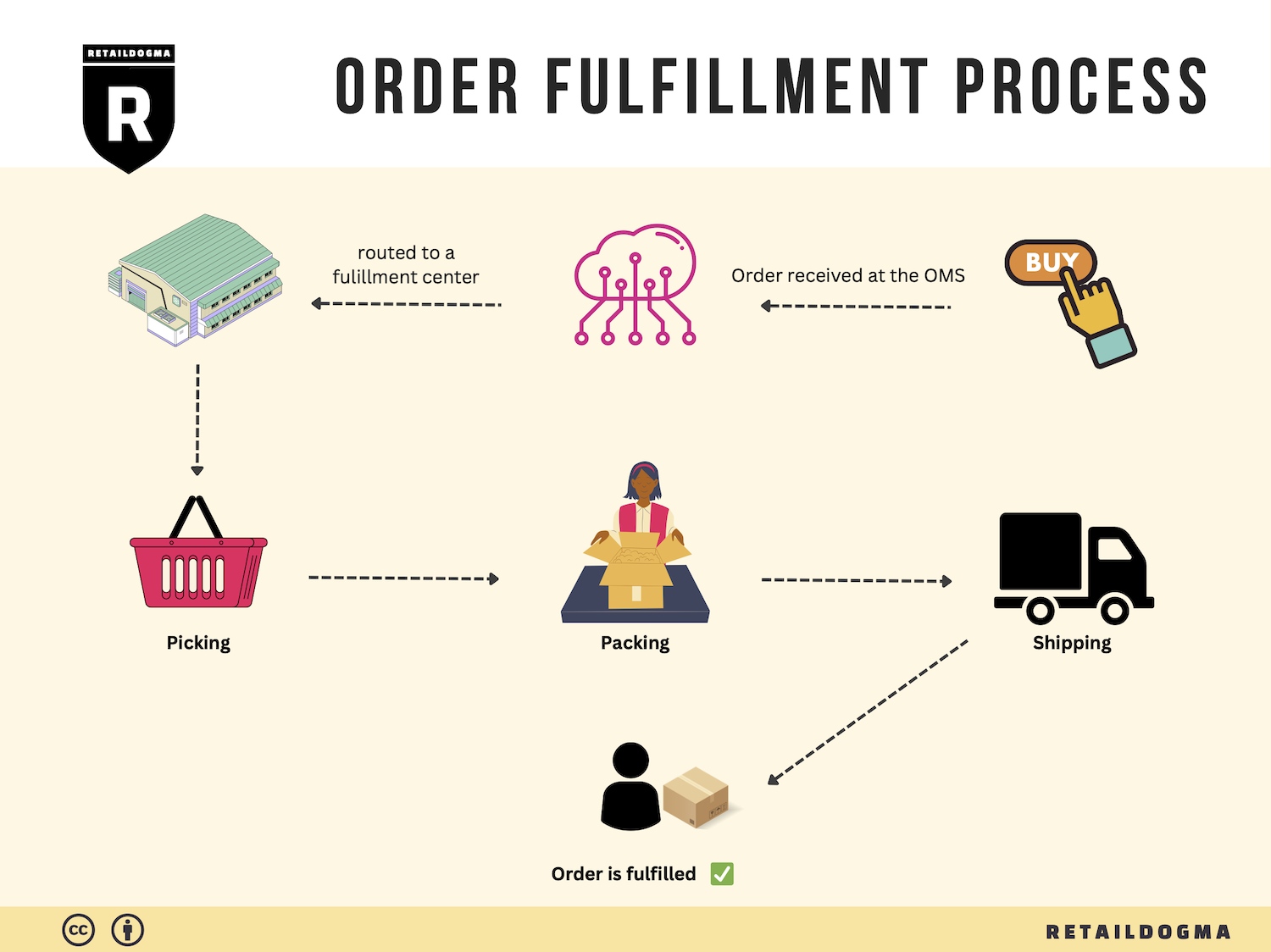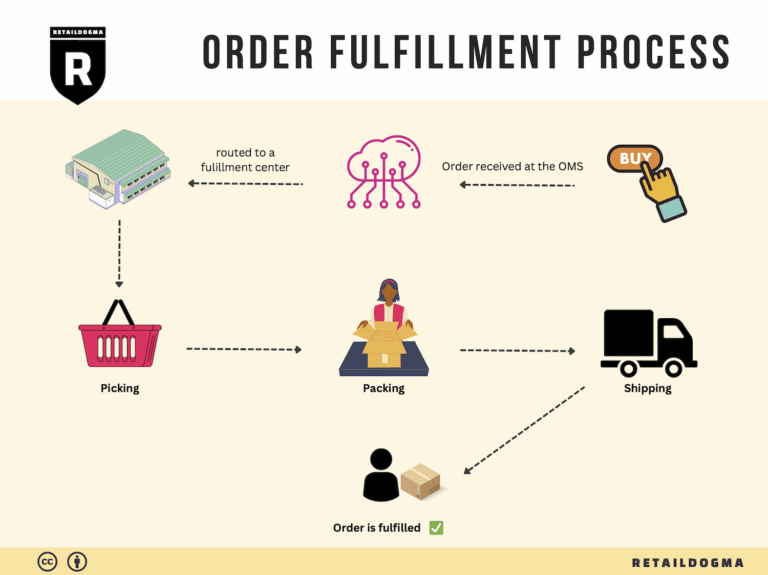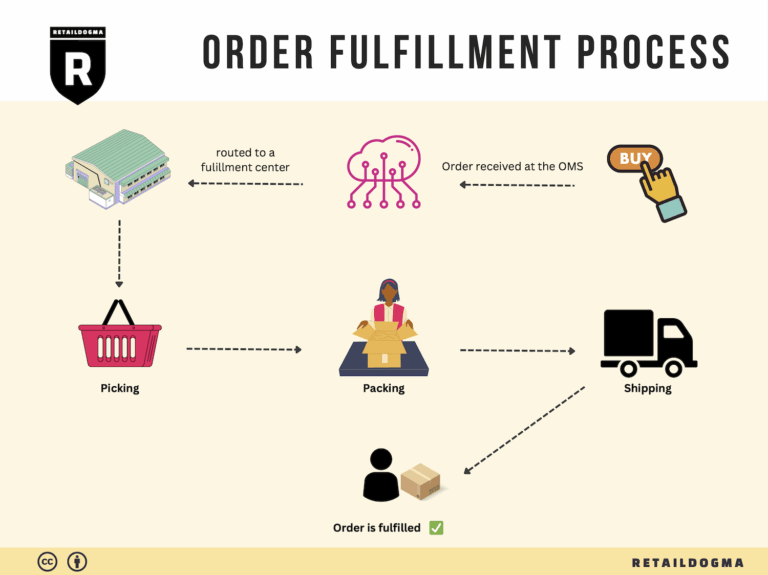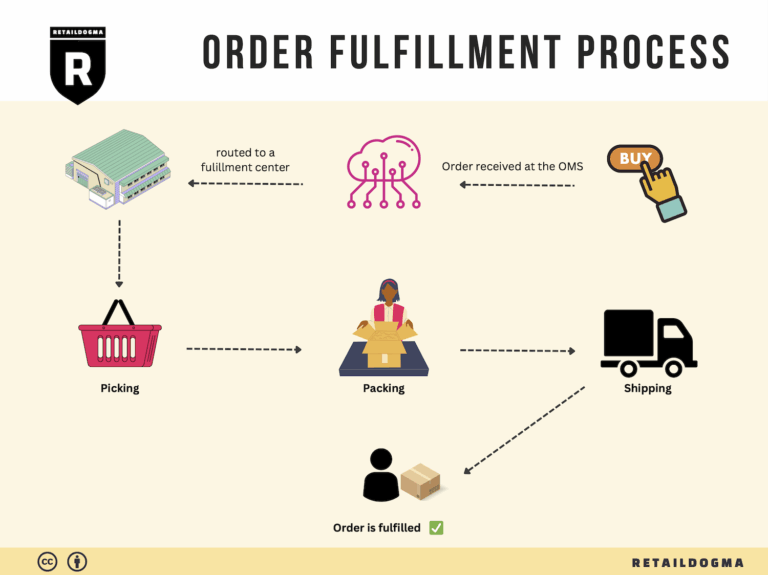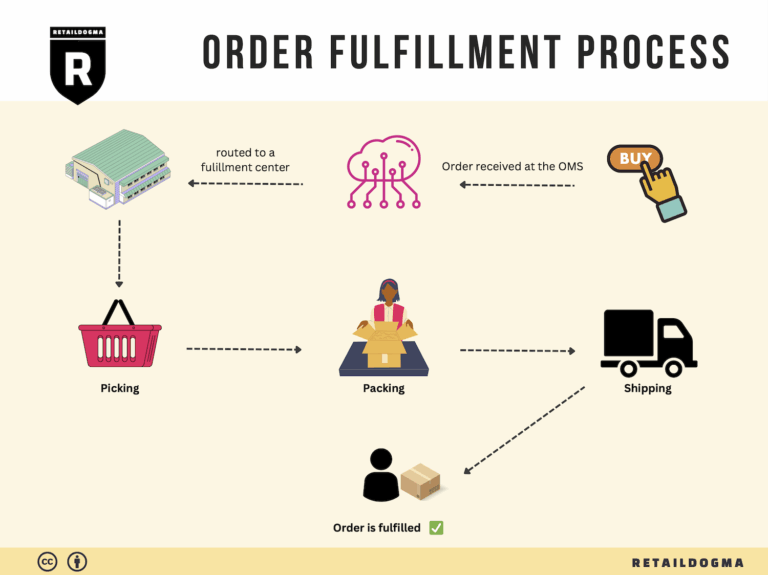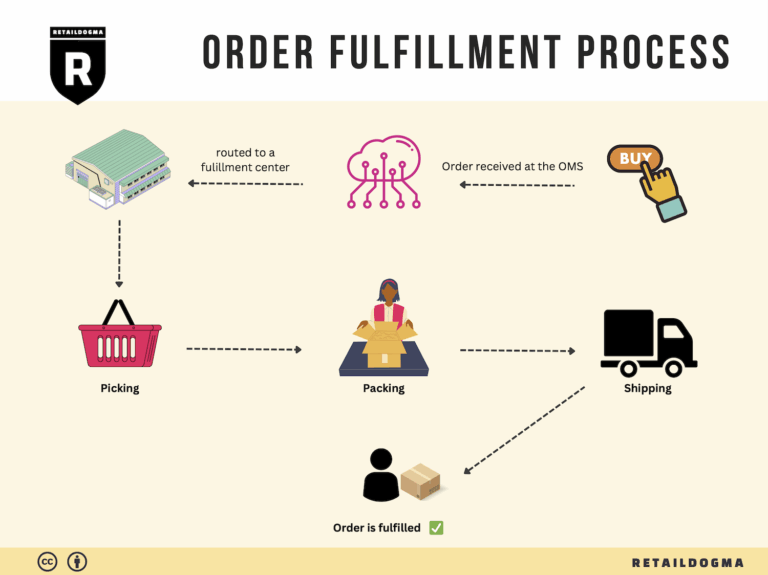What Is A Fulfillment Center? A Complete Guide (2025)
What is E-commerce Fulfillment? An Introduction for Growing Businesses
Understanding the Challenges of E-commerce Fulfillment
As a growing online business, you may find yourself overwhelmed by the sheer volume of orders coming in each day. The excitement of making sales can quickly turn into stress as you grapple with packing and shipping each order efficiently. The fulfillment process—the journey of getting a product from your warehouse to your customer’s doorstep—can become a daunting task, especially as your order volumes increase and customer expectations rise.
E-commerce fulfillment encompasses everything from receiving inventory and storing it, to processing orders, packaging products, and arranging for shipping. It’s a crucial element of your operations that can significantly impact customer satisfaction and retention. As your business scales, understanding the intricacies of fulfillment is essential to maintaining a competitive edge.
What This Guide Will Cover
In this guide, we will explore the various fulfillment models available to online businesses, such as Third-Party Logistics (3PL) and Fulfillment by Amazon (FBA). Each model has its unique advantages and challenges, and understanding them is vital for making informed decisions about your logistics.
We will delve into the core services that fulfillment partners typically offer, including inventory management, order processing, kitting, and shipping. Knowing what services are available will help you assess which partner aligns best with your business needs.
Choosing the right fulfillment partner can be a game-changer for your operations. We will provide insights on how to evaluate potential partners based on factors such as technology integration, scalability, and customer support. Additionally, we will discuss pricing structures, helping you understand the costs associated with different fulfillment solutions and how to budget effectively.
Empowering Your Business Decisions
The goal of this guide is to empower you with the knowledge needed to make smart decisions about your logistics strategy. By gaining a deeper understanding of e-commerce fulfillment, you can streamline your operations, enhance customer satisfaction, and ultimately drive growth for your business. Whether you’re just starting out or looking to scale, the right fulfillment strategy can set you on the path to success.
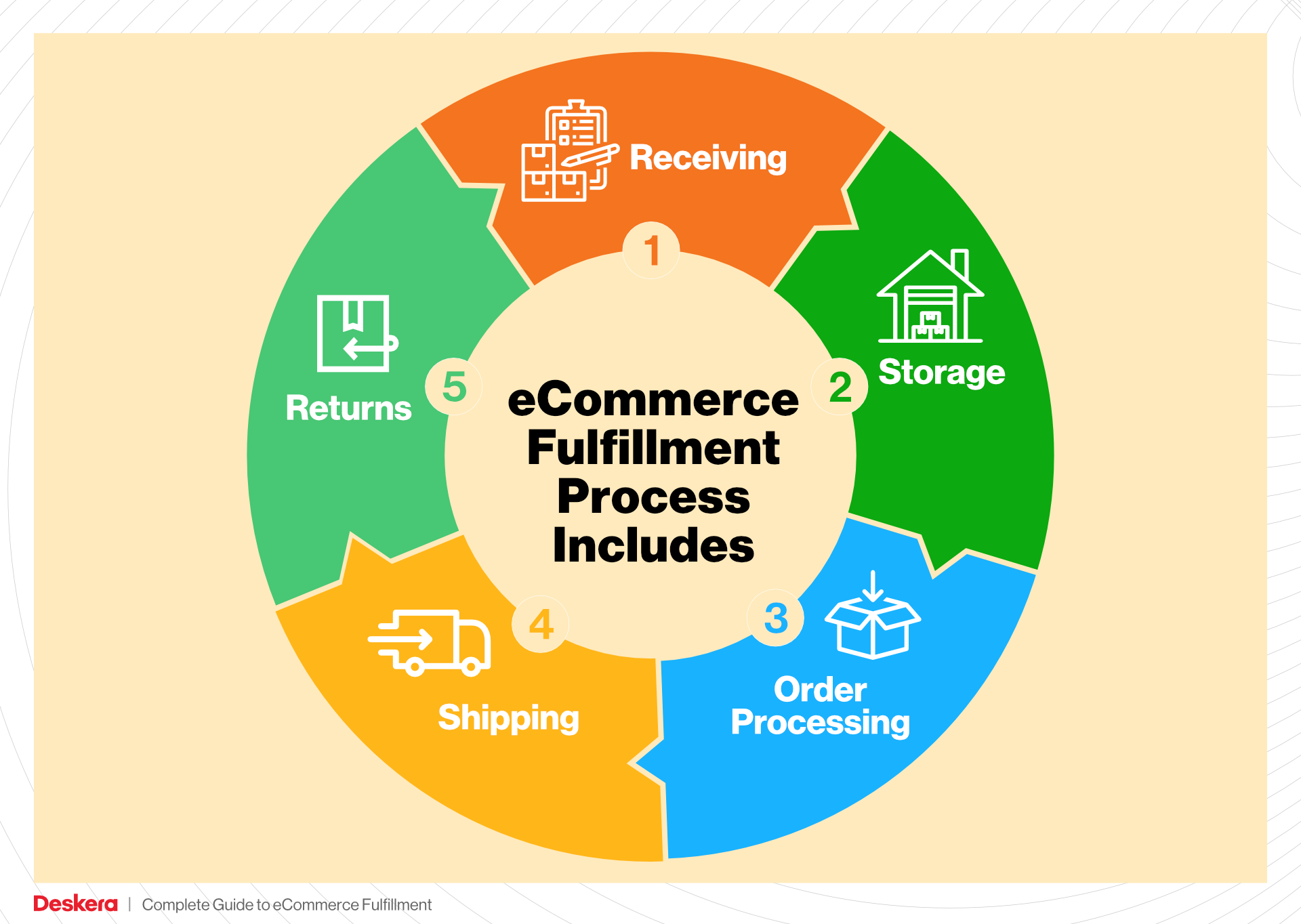
What You’ll Learn In This Guide
- What is E-commerce Fulfillment? An Introduction for Growing Businesses
- The Order Fulfillment Process: From ‘Buy’ Button to Customer’s Door
- Comparing Fulfillment Models: In-House vs. 3PL vs. Dropshipping
- A Deep Dive into Amazon FBA: Pros, Cons, and Who It’s For
- Core Services Offered by Fulfillment Centers
- How to Choose a Fulfillment Partner: A 6-Point Checklist
- Understanding Fulfillment Pricing: A Breakdown of Common Fees
- Frequently Asked Questions (FAQs) about Fulfillment
- Conclusion: Is Outsourcing Fulfillment the Right Move for Your Business?
- Important Disclaimer
The Order Fulfillment Process: From ‘Buy’ Button to Customer’s Door
1. Receiving Inventory
The first step in the order fulfillment process is receiving inventory. This involves accepting shipments of products from suppliers or manufacturers and verifying their accuracy against purchase orders. Each product is assigned a unique identifier, known as a Stock Keeping Unit (SKU), which facilitates efficient tracking and management within the warehouse.
Importance: Receiving inventory accurately is crucial because it sets the foundation for the entire fulfillment process. Mistakes at this stage can lead to stock discrepancies, which may result in overselling or stockouts. This can damage customer trust and lead to lost sales.
Key Term: SKU (Stock Keeping Unit) – A unique identifier for each product that helps in tracking inventory levels and sales.
2. Warehouse Storage
Once inventory is received and verified, the next step is warehouse storage. This involves organizing products within the warehouse in a manner that maximizes space and ensures easy access for future order fulfillment. Utilizing systematic storage solutions such as shelving, bins, and pallets helps in creating a logical flow and reduces time spent searching for items.
Importance: Efficient warehouse storage is vital for minimizing handling time during order picking. Proper organization can significantly enhance operational efficiency, allowing businesses to scale up without compromising on speed or accuracy. A well-structured storage system also aids in inventory management, making it easier to conduct regular stock counts and audits.
Key Term: FIFO (First In, First Out) – A method of inventory management where the oldest stock is sold first, reducing the risk of obsolescence and ensuring fresh products are delivered to customers.
3. Order Picking
Order picking is the process of selecting the correct items from the warehouse to fulfill customer orders. This step often utilizes pick lists, which are detailed documents that outline the items and quantities needed for each order. Depending on the size and complexity of the operation, businesses may employ various picking methods, such as single order picking, batch picking, or wave picking.
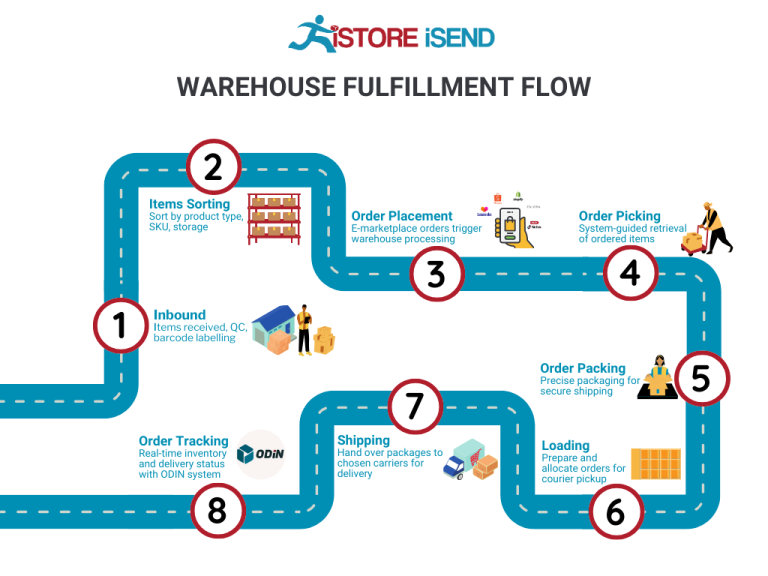
Importance: Accurate order picking is essential to maintaining high customer satisfaction. Errors during this stage can lead to incorrect shipments, resulting in returns and customer dissatisfaction. Streamlining the picking process can also reduce labor costs and improve turnaround times.
Key Term: Pick List – A document that specifies which items and quantities to collect from the warehouse for fulfilling an order.
4. Order Packing
After items have been picked, they are taken to the packing station where they are prepared for shipment. This involves checking the picked items against the order details, packing them securely in appropriate materials, and generating shipping labels. Effective packing not only protects products during transit but also enhances the unboxing experience for customers.
Importance: Packing is a critical step that directly impacts shipping costs and customer satisfaction. Properly packed orders reduce the risk of damage during transit, which can lead to costly replacements and dissatisfied customers. Additionally, using sustainable packing materials can enhance a brand’s image in an increasingly eco-conscious market.
Key Term: Packing Slip – A document included in the package that lists the items contained within, serving as a receipt for the customer.
5. Shipping & Delivery
The final step in the order fulfillment process is shipping and delivery. Once orders are packed, they are handed over to carriers for transportation to the customer’s address. This stage involves selecting the best shipping methods based on factors like cost, speed, and destination. Businesses often track shipments to provide customers with real-time updates on their order status.
Importance: The shipping and delivery phase is often the last touchpoint a customer has with a brand, making it crucial for customer satisfaction. Fast and reliable shipping can be a significant competitive advantage, as customers increasingly expect quick delivery times. Additionally, transparent communication regarding shipping can enhance the overall customer experience.
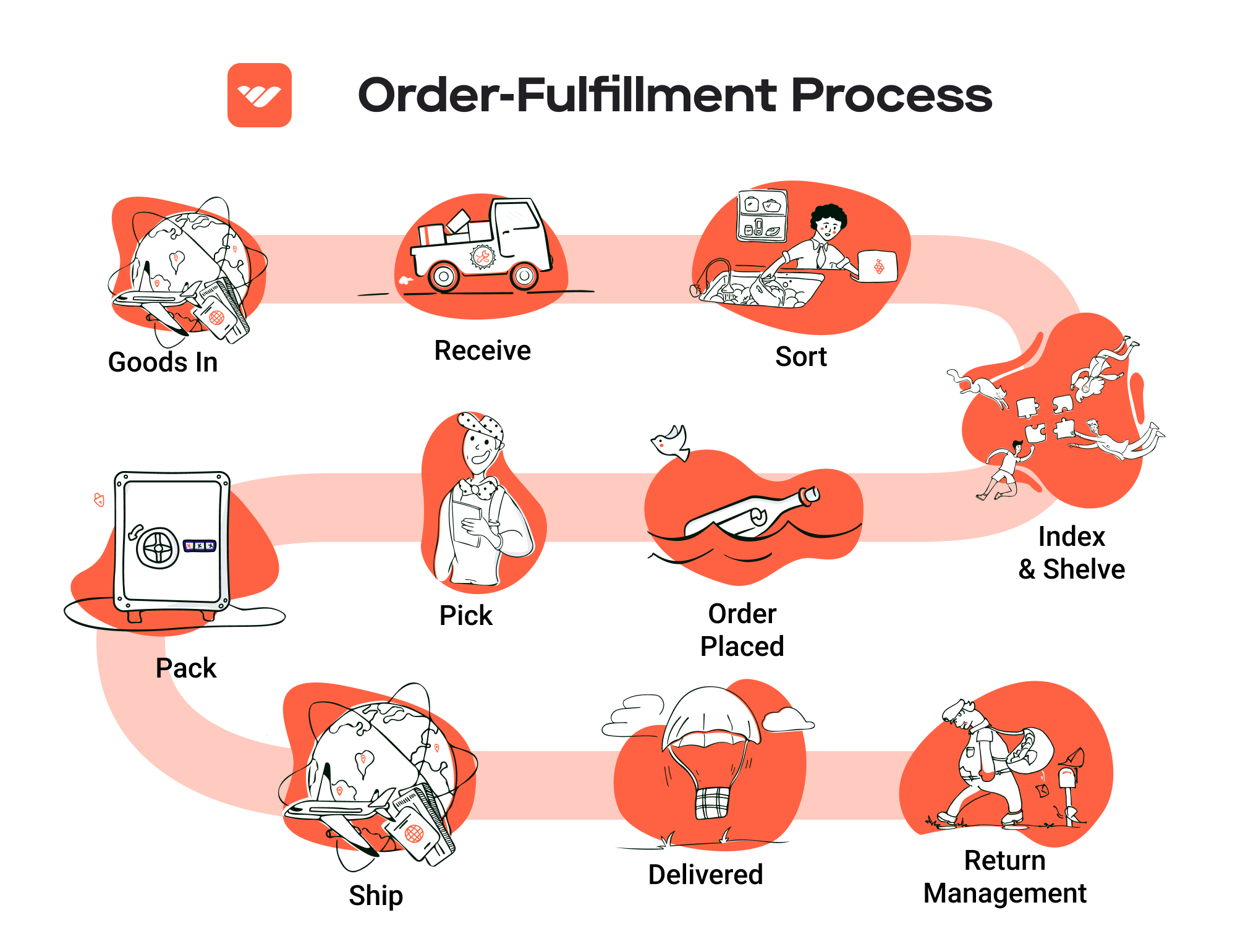
Key Term: Last Mile Delivery – The final step of the delivery process where the package is transported from a distribution center to the final delivery location, often considered the most crucial and complex part of the logistics chain.
By understanding and optimizing each of these five steps in the order fulfillment process, e-commerce businesses can enhance operational efficiency, improve customer satisfaction, and ultimately scale their operations successfully.
Comparing Fulfillment Models: In-House vs. 3PL vs. Dropshipping
Fulfillment Model Comparison
| Model | Who Handles Inventory | Best For (Business Stage) | Key Advantage | Key Disadvantage |
|---|---|---|---|---|
| In-House Fulfillment | The e-commerce business | Startups to mid-sized businesses | Full control over the process | High overhead and operational costs |
| Third-Party Logistics (3PL) | 3PL provider | Growing businesses | Scalability and expertise | Less control over operations |
| Dropshipping | Supplier or manufacturer | Startups and niche businesses | Low initial investment and risk | Longer shipping times and lower margins |
In-House Fulfillment
In-house fulfillment involves managing the entire inventory and order processing operation within the e-commerce business itself. This model is often adopted by startups and mid-sized companies that prefer to maintain complete control over their fulfillment processes. The key advantage of in-house fulfillment is the ability to oversee every aspect of the operation, from inventory management to shipping, which can enhance quality control and customer service. This model allows businesses to create tailored experiences for their customers, ensuring that packaging and branding align perfectly with their vision.
However, in-house fulfillment can come with significant downsides. The costs associated with maintaining a warehouse, staffing, and managing logistics can become overwhelming as order volumes grow. This model also requires substantial investments in technology and infrastructure to handle increasing complexity, such as inventory tracking systems and shipping solutions. Additionally, as businesses scale, they may face challenges in keeping up with rising customer expectations for speed and accuracy, leading to potential operational bottlenecks.
Third-Party Logistics (3PL)
Third-party logistics (3PL) providers, such as MAI Fulfillment, take over the warehousing, inventory management, and shipping processes on behalf of e-commerce businesses. This model is particularly advantageous for growing companies looking to scale without the burdens of managing logistics themselves. 3PLs offer a wealth of expertise in logistics and can provide advanced technology solutions, such as real-time inventory tracking and automation, that are often too costly for smaller businesses to implement independently.
One of the standout advantages of utilizing a 3PL is the scalability it offers. As a business grows, a 3PL can quickly adjust to increased order volumes, seasonal fluctuations, or market expansions without the need for the business to invest in additional infrastructure. However, a key disadvantage is the loss of control over fulfillment processes. Businesses must trust their 3PL partner to maintain high service levels, and any lapses in performance can directly impact customer satisfaction. Additionally, while 3PLs can streamline operations, businesses may face complexities in integrating their systems with those of the 3PL, especially if they are using niche or custom-built e-commerce platforms.
Dropshipping
Dropshipping is a fulfillment model where the e-commerce business sells products without holding any inventory. Instead, when a customer places an order, the business purchases the item from a third-party supplier who then ships it directly to the customer. This model is particularly appealing to startups and niche businesses due to its low upfront investment and minimal financial risk. Entrepreneurs can test new product ideas without the need for inventory storage or management, making it a flexible option for those looking to enter the market quickly.
The primary advantage of dropshipping is the reduced financial burden. Businesses do not need to invest in inventory upfront or worry about warehousing costs, which can significantly lower startup costs. However, dropshipping also has notable disadvantages. The reliance on suppliers for inventory means that businesses have less control over shipping times and product quality, which can lead to longer delivery times and potential customer dissatisfaction. Additionally, profit margins in dropshipping are often lower due to the costs associated with sourcing products from suppliers, which can limit scalability and profitability over time.
Conclusion
Choosing the right fulfillment model is crucial for the success and scalability of an e-commerce business. In-house fulfillment offers control but at a higher cost, while 3PLs provide expertise and scalability with some loss of control. Dropshipping presents a low-risk entry point but can compromise speed and margins. Business owners should carefully assess their current needs, growth projections, and operational capabilities to determine the most suitable fulfillment strategy for their unique circumstances.
A Deep Dive into Amazon FBA: Pros, Cons, and Who It’s For
Understanding Fulfillment by Amazon (FBA)
Fulfillment by Amazon (FBA) is a service that allows e-commerce sellers to store their products in Amazon’s fulfillment centers. Amazon takes care of storage, packaging, and shipping, while also handling customer service and returns. This model enables sellers to leverage Amazon’s extensive logistics network and customer base, significantly reducing the operational burden associated with order fulfillment.
When a customer makes a purchase from a seller using FBA, Amazon picks, packs, and ships the product directly to the customer. This process can enhance the customer experience by providing fast and reliable shipping options, including Amazon Prime delivery. Sellers can also benefit from Amazon’s customer service and return handling, which can be particularly advantageous for those new to e-commerce.
How FBA Works
-
Inventory Management: Sellers send their products to Amazon’s fulfillment centers. Amazon provides guidelines on how to prepare and label products to ensure they meet their requirements.
-
Storage: Once the products arrive at the fulfillment center, they are stored until a customer places an order. Amazon uses sophisticated inventory management systems to track stock levels in real-time.
-
Order Fulfillment: When an order is placed, Amazon’s systems automatically pick the product from the inventory, pack it, and ship it to the customer. Sellers can monitor their inventory and sales through the Amazon Seller Central platform.
-
Customer Service: Amazon manages customer inquiries and returns for FBA orders, allowing sellers to focus on growing their business instead of handling day-to-day customer service issues.
-
Returns Management: Amazon also handles returns for FBA products, making the process seamless for both sellers and customers.
Pros of Using Amazon FBA
1. Prime Eligibility
One of the most significant advantages of using FBA is that it makes your products eligible for Amazon Prime. This means that Prime members can enjoy free two-day shipping on your products, which can significantly increase sales potential. The Prime badge also adds a level of trust and credibility to your listings, as customers often prefer purchasing from Prime-eligible sellers.
2. Increased Customer Trust
Amazon has built a reputation for reliability and customer service. By using FBA, sellers can leverage this trust. Customers are more likely to purchase from sellers who use FBA because they know that Amazon will handle their order efficiently and provide support if needed.
3. Multi-Channel Fulfillment
FBA isn’t just limited to Amazon sales. Sellers can use FBA for orders from their own websites or other platforms as well. This multi-channel fulfillment capability allows businesses to streamline their logistics, ensuring that they can meet customer demands across various sales channels while still benefiting from Amazon’s logistics expertise.
4. Time-Saving
By outsourcing fulfillment to Amazon, sellers can save considerable time and effort that would otherwise be spent on packing, shipping, and customer service. This allows them to focus on other critical aspects of their business, such as marketing and product development.
5. Scalability
FBA allows businesses to scale quickly without worrying about the complexities of warehousing and logistics. As demand grows, sellers can send more inventory to Amazon’s fulfillment centers, and Amazon will handle the increased order volume.
Cons of Using Amazon FBA
1. High Fees
While FBA offers many benefits, it comes with costs that can add up quickly. Amazon charges storage fees for the inventory stored in their fulfillment centers and fulfillment fees for each order processed. These fees can significantly eat into profit margins, especially for low-cost or slow-moving items.
2. Strict Inventory Rules
Amazon has strict guidelines regarding inventory management. Sellers must adhere to these rules to avoid penalties, including removal fees for excess inventory or long-term storage fees for items that don’t sell. This can create pressure to sell through inventory quickly, which may not always align with a seller’s business strategy.
3. Commingling Risks
When products are commingled, it means that your inventory is mixed with that of other sellers. While this can lead to faster shipping times, it also poses a risk of receiving damaged or incorrect items from customers. If a customer returns an item, it may not be the same item that was originally shipped, leading to potential issues with quality control and customer satisfaction.
4. Limited Control
By using FBA, sellers relinquish some control over their inventory and fulfillment processes. This can be a disadvantage for businesses that prefer to manage their own logistics or have specific requirements for order fulfillment.
5. Dependency on Amazon
Relying heavily on FBA can create a dependency on Amazon’s platform. Changes in Amazon’s policies, fees, or algorithms can have a significant impact on a seller’s business, making it important to have a diversified sales strategy.
Who is FBA Best For?
FBA is particularly suited for:
- Small to Medium-Sized Businesses: Companies looking to scale quickly without the overhead of managing their own warehousing and fulfillment operations can benefit significantly from FBA.
- Brands with High Sales Volume: Businesses that sell high volumes of products and can absorb FBA fees may find that the advantages of speed and customer service outweigh the costs.
- New Sellers: Entrepreneurs entering the e-commerce space can leverage FBA to provide a professional level of service without needing extensive logistics experience.
- Multi-Channel Sellers: Brands that sell on multiple platforms can streamline their operations by using FBA for order fulfillment across all channels, enhancing efficiency and accuracy.
In conclusion, while Fulfillment by Amazon presents an attractive option for many e-commerce businesses, it’s essential to weigh the pros and cons carefully. Understanding your unique business needs and sales strategy will help you determine if FBA is the right fit for your operations.
Core Services Offered by Fulfillment Centers
Inventory Management & Warehousing
Effective inventory management is the cornerstone of successful e-commerce operations. Fulfillment centers offer sophisticated inventory management systems (IMS) that provide real-time visibility into stock levels across all sales channels. This service includes tracking inventory, managing stock replenishment, and synchronizing data across multiple platforms, which is critical for avoiding overselling and stockouts.
The benefits of robust inventory management for e-commerce businesses are manifold. First, it ensures that products are readily available when customers want them, which enhances customer satisfaction and loyalty. Second, accurate inventory tracking helps businesses reduce excess stock, minimizing holding costs and freeing up cash flow for other operational needs. Additionally, with the right warehouse management systems (WMS), businesses can automate inventory tracking and reporting, allowing for more strategic decision-making based on data insights. This leads to improved operational efficiency and scalability, making it easier for brands to grow without the risk of logistical bottlenecks.
Pick and Pack Services
Pick and pack services are essential for e-commerce fulfillment, as they involve the process of retrieving items from inventory (picking) and preparing them for shipment (packing). Fulfillment centers utilize advanced technology and skilled labor to streamline this process, ensuring that orders are fulfilled quickly and accurately.
The advantages of efficient pick and pack services are significant. Speed is a critical factor in e-commerce, and fast order processing can significantly enhance customer satisfaction. By utilizing automated systems for picking and packing, fulfillment centers can minimize human error and increase order accuracy, which is vital for maintaining a positive brand reputation. Furthermore, with same-day shipping options available, businesses can meet consumer expectations for fast delivery, setting themselves apart from competitors. This service not only optimizes the logistics of order fulfillment but also enables e-commerce businesses to scale operations seamlessly as demand fluctuates.
Kitting and Assembly
Kitting and assembly services involve the grouping of individual products into ready-to-ship kits, or the assembly of products before they are shipped to customers. This service is particularly beneficial for brands that offer subscription boxes, promotional bundles, or customized product packages. Fulfillment centers utilize the latest logistics technology to efficiently manage kitting processes, ensuring that products are assembled with precision and care.
The primary benefit of kitting and assembly services is the ability to offer customers unique product combinations that enhance their shopping experience. By providing customized bundles, brands can increase average order value and create upsell opportunities. Additionally, kitting can streamline the fulfillment process by reducing the number of individual items that need to be picked and packed. This not only saves time but also helps to minimize errors during order fulfillment. For businesses looking to differentiate themselves in a competitive market, kitting and assembly services offer a strategic advantage by allowing them to deliver tailored solutions that meet specific customer needs.
Returns Management (Reverse Logistics)
Returns management, often referred to as reverse logistics, is a critical component of the fulfillment process that focuses on efficiently handling returned merchandise. Fulfillment centers provide comprehensive returns management services that include processing returns, restocking items, and managing customer communications related to returns.
The importance of effective returns management cannot be overstated. A streamlined returns process can significantly enhance customer satisfaction and loyalty, as consumers are more likely to shop with brands that offer hassle-free returns. Additionally, efficient returns processing helps businesses recover value from returned items, whether through restocking, refurbishing, or reselling. This can mitigate losses associated with returns and contribute to overall profitability. Moreover, fulfillment centers can provide valuable insights into return trends and reasons, allowing businesses to identify and address underlying issues with products or services. By optimizing returns management, e-commerce businesses can turn a potential pain point into a competitive advantage, fostering trust and encouraging repeat purchases.
In summary, fulfillment centers provide a suite of essential services that empower e-commerce businesses to operate efficiently and scale effectively. By leveraging inventory management, pick and pack services, kitting and assembly, and returns management, brands can enhance their logistics operations and deliver exceptional customer experiences. As the e-commerce landscape continues to evolve, partnering with a capable fulfillment center can be a strategic move towards sustained growth and success.
How to Choose a Fulfillment Partner: A 6-Point Checklist
Location & Warehouse Network
Importance: The geographical location of your fulfillment partner’s warehouses can significantly impact shipping times and costs. A strategically placed warehouse network allows for faster delivery to your customer base, which is essential for maintaining customer satisfaction and competitiveness.
Questions to Ask:
– What is the location of your warehouses, and how do they align with my target market?
– Do you have multiple warehouse locations, and can you scale to other regions if needed?
– How do you handle shipping logistics for international orders?
Technology & Integrations
Importance: In today’s fast-paced e-commerce environment, technology plays a crucial role in efficiency and accuracy. A partner with robust technology solutions can streamline your operations, minimize errors, and provide real-time visibility into inventory and order status.
Questions to Ask:
– What type of Warehouse Management System (WMS) do you use, and how customizable is it?
– Can your system integrate seamlessly with my existing e-commerce platforms (e.g., Shopify, Amazon)?
– How do you ensure data accuracy and real-time updates across all sales channels?
Specializations (e.g., Cold Storage, Oversized Items)
Importance: Depending on your product offerings, you may require a fulfillment partner with specific capabilities. Whether you sell perishable goods that need cold storage or oversized items that require special handling, ensure your partner can meet these unique needs.
Questions to Ask:
– Do you have specialized facilities for handling specific types of products, such as temperature-sensitive items or bulky goods?
– What are your capabilities for kitting or custom assembly if my products require it?
– Can you accommodate seasonal fluctuations in product types or volumes?
Scalability & Capacity
Importance: As your business grows, your fulfillment needs will evolve. A partner that can scale operations quickly and efficiently will help you avoid bottlenecks during peak seasons and ensure that you can meet increasing customer demands without compromising service quality.
Questions to Ask:
– How do you handle increases in order volume during peak seasons?
– Can you provide a clear outline of your capacity limits and how you manage excess demand?
– What is your process for onboarding new clients or expanding services?
Pricing and Contracts
Importance: Understanding the pricing structure and contractual obligations is crucial for maintaining profitability. Transparent pricing helps you budget effectively and avoid unexpected costs that can arise from hidden fees or unfavorable terms.
Questions to Ask:
– What is included in your pricing structure (e.g., pick and pack fees, storage fees, shipping rates)?
– Do you offer flat-rate pricing, or are costs variable based on demand?
– What are the terms regarding contract length, and what is the process for termination or renewal?
Customer Support & Reviews
Importance: Reliable customer support can make or break your fulfillment experience. A partner that prioritizes customer service will be more responsive to your needs and can help resolve issues quickly, ensuring that your operations run smoothly.
Questions to Ask:
– What kind of customer support do you provide (e.g., dedicated account manager, 24/7 support)?
– Can you share testimonials or case studies from current clients that illustrate your service quality?
– How do you handle disputes or issues that may arise during the fulfillment process?
Conclusion
Choosing the right fulfillment partner is a critical decision that can significantly affect your e-commerce business’s success. By carefully considering these six key areas—Location & Warehouse Network, Technology & Integrations, Specializations, Scalability & Capacity, Pricing and Contracts, and Customer Support & Reviews—you can make a more informed decision that aligns with your business goals.
Take the time to ask these questions and evaluate potential partners thoroughly. The right fulfillment partner will not only support your current needs but also help you scale efficiently as your business grows.
Understanding Fulfillment Pricing: A Breakdown of Common Fees
Initial Setup Fees
When partnering with a fulfillment provider, businesses often encounter initial setup fees. These fees cover the cost of integrating your e-commerce platform with the fulfillment provider’s system, configuring your inventory, and establishing workflows tailored to your operational needs. The setup process may include creating product listings, uploading inventory data, and training your staff on how to use the fulfillment system effectively.
Initial setup fees can vary significantly depending on the complexity of your requirements. For instance, a straightforward integration with a popular e-commerce platform like Shopify may incur lower fees compared to a custom-built solution requiring extensive API development. Generally, expect to pay a one-time fee that can range from a few hundred to several thousand dollars, depending on the service level and customization needed.
Receiving Fees
Receiving fees are charged when your inventory arrives at the fulfillment center. This fee covers the labor and resources necessary to unload, inspect, and store your products. The cost is typically calculated per shipment or per unit received.
For example, if you send a pallet of 100 items, the receiving fee may be a flat rate for the entire pallet or a per-item rate, which means you would pay a certain amount for each item that is processed upon arrival. Factors affecting receiving fees include the complexity of your inventory (e.g., bulk versus individual items), the volume of products, and any specific handling requirements (like fragile items).
Storage Fees (per pallet/bin)
Storage fees are incurred for keeping your inventory within the fulfillment center. These fees are typically charged monthly and can be based on the space your inventory occupies, measured in pallets or bins.
For instance, if you store a pallet of goods that takes up a specific amount of space, you will be charged a fixed fee for that pallet each month. Some fulfillment centers may offer tiered pricing based on volume, meaning that the more pallets you store, the lower your per-pallet cost may become. Additionally, some companies charge for space occupied rather than just the number of pallets, making it crucial to understand how your products will be stored to estimate these costs accurately.
Pick & Pack Fees (per item/order)
Pick and pack fees are charged for the labor involved in retrieving items from storage and preparing them for shipment. This fee is typically calculated on a per-item or per-order basis.
For example, if a customer orders three different items, the pick and pack fee may cover the cost of selecting all three items from the warehouse, packing them into a box, and preparing the shipment. Some fulfillment providers may charge a flat fee per order, while others may charge based on the number of items in the order. Understanding this fee structure is critical, especially for businesses with a high number of SKU variations or frequent order changes, as these can significantly impact overall fulfillment costs.
Shipping Fees
Shipping fees are one of the most variable costs in the fulfillment pricing model. These fees depend on several factors, including the shipping carrier used, the destination of the shipment, the weight and dimensions of the package, and the shipping speed selected (e.g., standard, expedited, or overnight).
Fulfillment centers often negotiate shipping rates with carriers, allowing them to pass on some savings to their clients. Businesses can benefit from understanding the shipping options available, including flat-rate shipping, zone-based pricing, and special rates for bulk shipments. It’s essential to clarify how shipping fees are calculated and whether they are included in the overall fulfillment pricing or charged separately.
Tips for Getting an Accurate Quote
-
Provide Detailed Information: When requesting a quote, ensure you provide comprehensive information about your business model, average order sizes, product types, and anticipated order volume. The more precise the details, the more accurate the quote will be.
-
Ask About Fee Structures: Different fulfillment providers have varied pricing models. Be sure to ask for clarity on all potential fees, including any hidden costs that may arise during peak seasons or for specific services like kitting or returns processing.
-
Evaluate Scalability: As your business grows, so will your fulfillment needs. Inquire about how fees may change with increased volume and whether the provider offers flexible pricing options that can scale with your business.
-
Compare Multiple Providers: Don’t settle for the first quote you receive. Obtain quotes from multiple fulfillment centers to compare pricing structures, services offered, and any additional benefits they may provide.
-
Consider Technology Integration: Evaluate whether the provider’s technology aligns with your e-commerce platform. This can save you time and money by reducing manual processes and potential errors.
By understanding these common fulfillment pricing models and following these tips, e-commerce business owners can make informed decisions that support their growth while managing costs effectively.
Frequently Asked Questions (FAQs) about Fulfillment
1. What is MAI Fulfillment?
MAI Fulfillment is a leading third-party logistics (3PL) provider that specializes in e-commerce order fulfillment. We offer a range of services including warehousing, inventory management, kitting, and fast shipping solutions. Our technology-driven approach allows seamless integration with various e-commerce platforms, enabling businesses to scale efficiently.
2. What is a 3PL?
A third-party logistics (3PL) provider is a company that offers outsourced logistics services, which can include warehousing, order fulfillment, shipping, and inventory management. By partnering with a 3PL like MAI Fulfillment, e-commerce businesses can focus on growth while leaving the complexities of logistics and fulfillment to experts.
3. How does MAI Fulfillment integrate with my e-commerce platform?
MAI Fulfillment offers seamless integration with over 100 e-commerce platforms, including Shopify, Amazon, WooCommerce, and more. Our customizable Warehouse Management System (WMS) ensures real-time inventory tracking and order processing, allowing you to manage multiple sales channels from a single interface.
4. What types of fulfillment services does MAI Fulfillment offer?
We provide a comprehensive range of fulfillment services, including Direct-to-Consumer (DTC) fulfillment, B2B order fulfillment, subscription box services, and kitting. Each service is tailored to meet the specific needs of our clients, ensuring efficiency and scalability.
5. How much do fulfillment services cost?
The cost of fulfillment services varies based on factors such as order volume, storage needs, and specific service requirements. At MAI Fulfillment, we offer flat-rate, transparent pricing to help businesses manage costs predictably. To get an accurate quote tailored to your needs, it’s best to contact us directly.
6. What’s the difference between a warehouse and a fulfillment center?
A warehouse primarily focuses on storing goods, whereas a fulfillment center is designed to manage the entire order fulfillment process, including picking, packing, and shipping products directly to customers. Fulfillment centers like MAI Fulfillment are equipped with technology and systems to streamline these operations.
7. How does MAI Fulfillment handle inventory management?
We utilize advanced inventory management systems (IMS) and warehouse management systems (WMS) to provide real-time visibility into stock levels. This ensures accurate tracking, optimizes stock movement, and minimizes risks of overselling or stockouts across multiple sales channels.
8. Can MAI Fulfillment support omnichannel sales strategies?
Yes, MAI Fulfillment excels at omnichannel fulfillment, allowing businesses to sell across multiple platforms—such as online stores and marketplaces—efficiently. Our integrated systems ensure a unified view of inventory and order flow, enhancing speed and accuracy in the fulfillment process.
9. What is kitting, and how does MAI Fulfillment support it?
Kitting is the process of assembling individual items into ready-to-ship packages or kits. MAI Fulfillment offers kitting services that include sourcing materials and assembling products, enabling businesses to deliver customized orders efficiently while reducing operational complexities.
10. How quickly can orders be fulfilled and shipped with MAI Fulfillment?
Our fulfillment services prioritize speed, with options for same-day shipping and 2-day delivery. This ensures your customers receive their orders promptly, which is crucial for maintaining high satisfaction levels and a competitive edge in the market.
Conclusion: Is Outsourcing Fulfillment the Right Move for Your Business?
Key Benefits of Outsourcing Fulfillment
Outsourcing your fulfillment process can be a game-changer for your e-commerce business. One of the most significant advantages is the substantial time savings it offers. By partnering with a reliable fulfillment service like MAI Fulfillment, you can shift your focus away from the complexities of warehousing, order processing, and shipping, allowing you to concentrate on core business activities such as marketing and product development.
Scalability is another critical benefit. As your business grows, so do your fulfillment needs. A proficient 3PL provider can easily adapt to fluctuating order volumes, ensuring that you can meet customer demands without compromising on speed or accuracy. This flexibility is essential in today’s fast-paced e-commerce landscape, where customer expectations are constantly evolving.
Moreover, outsourcing fulfillment allows you to leverage the expertise of seasoned professionals. Established fulfillment partners come equipped with advanced technology, industry insights, and proven strategies that can enhance your operational efficiency. They can help mitigate common challenges like inventory management, shipping delays, and order inaccuracies, ultimately leading to improved customer satisfaction.
Choosing the Right Partner for Growth
However, the key to reaping these benefits lies in selecting the right fulfillment partner. A thorough evaluation of potential partners should include their technology capabilities, customer service approach, and alignment with your business goals. A strategic partnership can empower your growth trajectory and help you navigate the complexities of e-commerce logistics.
Call to Action
To determine if outsourcing fulfillment is the right move for your business, consider conducting a comprehensive audit of your current shipping and fulfillment processes. Assess areas where inefficiencies exist, and explore how a dedicated fulfillment partner could streamline operations and enhance customer experience. Taking this critical step could be the catalyst for your business’s next phase of growth.
Important Disclaimer
⚠️ Important Disclaimer
The information in this guide is for educational purposes. Fulfillment services, pricing, and platform features change frequently. Always conduct your own due diligence and consult with providers directly before making business decisions.
